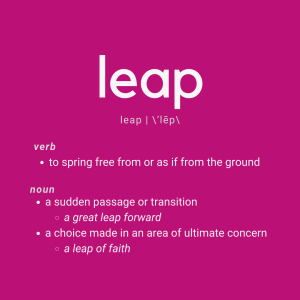 What’s bugging you? Is there a situation at work or elsewhere that is stuck in your mind? You know, the loop of an idea that gets wedged into your noggin and played on repeat. It’s likely something to figure-out or confront or resolve or explore, but, somehow, you haven’t talked about it. Sometimes not talking is fine – talk for the sake of talking is not always useful. But avoiding a conversation can be a waste of time.
What’s bugging you? Is there a situation at work or elsewhere that is stuck in your mind? You know, the loop of an idea that gets wedged into your noggin and played on repeat. It’s likely something to figure-out or confront or resolve or explore, but, somehow, you haven’t talked about it. Sometimes not talking is fine – talk for the sake of talking is not always useful. But avoiding a conversation can be a waste of time.
I’m willing to bet that if you are spending your time not discussing an idea or addressing an issue, you are also spending energy to do the same thing. It’s takes effort to simultaneously think about a topic and not talk about it. It’s a lot of inefficient work. So, what would I recommend? Start talking and do it well.
“Fine,” you say. “But when I start talking about this loop in my head, things might get awkward.” I totally understand – I’ve had my share of bad conversations because I opened my mouth at imprudent times or without much organized forethought. There are a few things you can do to help get yourself set-up to have conversations that work. Here’s the first thing to think about:
Communicate Clearly
It sounds obvious, but it’s often overlooked. Break it down like this:
1) What’s your vision of the situation?

- In your mind’s eye, what is the best outcome? See it as an image – a painting, a photo, a symbol – find a something that represents what you want.
- Having a visual anchor helps your brain help you by engaging the visual cortex – a picture is worth a thousand words and millions of neurons.
2) Ask basic questions: Who, What, Where, When, Why, How & If, then
- Just the facts, ma’am
- Think with a curious and investigative mind then sift through the superfluous stuff to get to the salient points
- Write this down
3) Relate these answers to your vision
- Does your answer to the question “where” align with your vision of your desired outcome?
- If so, great; if not – it can be a point to discuss, clarify and resolve.
4) How do you feel about the topic? (Yes, I asked how you feel)

- People get stuck trying to eliminate emotions and feelings from their conversations because we expect them to be volatile. They don’t have to be!
- Emotions are valuable data if you actually notice them and treat them as such: “I feel a little worried about our launch date,” or “I am really happy about the team I’m working with.”
- Worried and happy are data points, just like there are three people on this team and the launch date is June 1.
- If you ignore any of that data, it makes success and clear communication harder
- Including the data of emotion into your clear communication can help you provide a well-rounded view of what you want to communicate
- The data of emotion helps you connect back to your vision
- Also, you cannot make a decision without an emotion.[1] Really. Neurologically, it cannot be done.
- Knowledge is power
5) Organize all of this data into a clear idea – boil it down to its essence
- Write this down, sketch-it, get crazy with post-it notes – whatever will work for you. Just get the clear data where you can see it.
- Then consolidate your information to a single sentence (a long sentence is fine, but try to keep it focused).
6) Share that clear idea with the people who need it.
- Schedule a time to start the conversation…
…this is the beginning. Up next: setting expectations in conversation.
[1] Damasio, A. R. (2003). Looking for Spinoza: joy, sorrow and the feeling brain. Orlando: Harcourt Inc.; Damasio, A. R. (1999). The feeling of what happens : Body and emotion in the making of consciousness. New York : Harcourt Brace





